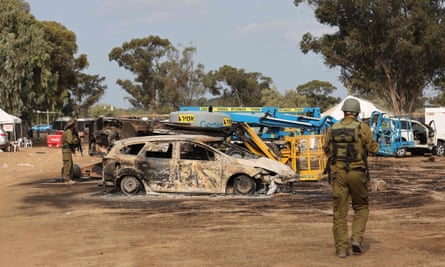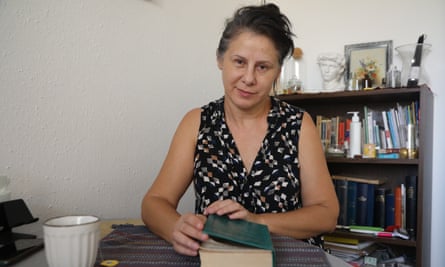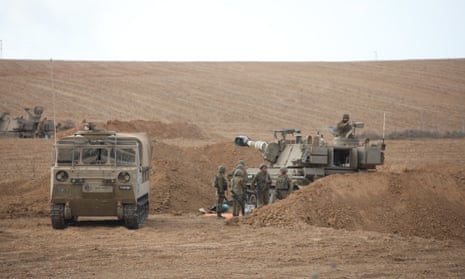Road 232, an Israeli highway, runs parallel to the blockaded Gaza Strip. It is surrounded by flat agricultural land in every direction, and from it the higher floors of the overcrowded enclave’s high rise buildings are clearly visible, about 3 miles (5km) away.
Now, the route appears to have become the new de facto boundary between territory controlled by Israel and Hamas, the Islamist movement that launched a devastating surprise sea, land and air offensive on 20 neighbouring kibbutzim and Israeli towns last weekend. They slaughtered more than 1,000 people, and abducted dozens more to be used as bargaining chips. More than 900 people in Gaza have been killed in retaliatory Israeli airstrikes.
It is not just a new border: it is a new frontline. Early on Tuesday, four days into the fifth round of war since Hamas seized control of Gaza in 2007, the Israel Defence Forces (IDF) said that Israel’s perimeter with the strip had finally been secured – but by midmorning, that was no longer the case.
The boom and crump of airstrikes and artillery, along with the rattle of automatic gunfire, echoed across the empty fields; a convoy of Israeli tanks roared past, sending soil and dust metres up into the air. Two military helicopters hovered overhead and jumpy soldiers at checkpoints bristled at every distant movement. Huge plumes of black smoke rose above Gaza.

Kibbutz Re’im, off Road 232, is where 260 partygoers at an all-night rave were massacred at daybreak on Saturday. Survivors have told of playing dead next to bodies of their friends and watching women being raped before they were shot in the head, or tied up and burned. On the outskirts of the kibbutz, the bodies of Israelis have now all been removed. Those of the men who murdered them remain.
On the sides of the road were the rotting corpses of five men, stripped to their underwear, after being checked for explosives. All were surrounded by piles of clothing and military equipment bearing the green insignia of Hamas, and the white of Palestinian Islamic Jihad. One was missing his head. Shot-up and abandoned cars bearing both Israeli and Palestinian licence plates were scattered up and down the highway.
In Sderot, a working class town on the north-east corner of Gaza, the situation was not much better. Katry Kamenetski, 48, who moved to Israel from Moldova six years ago, never really liked the place. But after hiding in her apartment with her 23-year-old daughter for four days, watching the battle between Israeli forces and gunmen who seized the police station over the road, she was happy to get outside on Tuesday, even if air raid sirens meant ducking into public bomb shelters every so often.
“There were Israeli snipers on our roof, we could hear them. The electricity and water kept going off. We sat in the dark with absolutely no idea what was going on … I am only learning the full picture today,” she said.

“We got very contradictory messages. Sometimes, the municipality WhatsApp or social media said it was OK to go out, everything was over, even though it wasn’t. They were still finding terrorists in searches of houses.
“On Monday, my boss actually asked if I was going to be coming into the office.”
As she spoke, the sound of bulldozers demolishing the police station could be heard over the road. The IDF regained control over it on Sunday after an intense firefight. Ten militants were killed in what Israel’s armed forces call a “pressure cooker” operation – steadily increasing fire on a building in which armed Palestinians are holed up, and using increasingly heavy weaponry, from more and more angles, until either they surrender or the building caves in on them. In almost all cases, it is the latter.
Elsewhere in the centre of Sderot, a town of 28,000 people, there was evidence of heavy fighting on a main street; a playground on one side of the road, a library on the other, and burnt-out, bullet-riddled vehicles in between. A missile thudded into a building a few streets over and the air defence system began to blare constantly as a car carrying two volunteers showed up.
Netan El, 19, from central Israel, shrugged off questions about the danger he faced in delivering food and supplies to families in the town. “It’s what we do,” he said.
On Monday night, Israelis were told by the Home Front to prepare a safe place to shelter and enough food, water and other supplies to last 72 hours – a clear sign that a ground offensive into Gaza is imminent. The move will undoubtedly claim many more Palestinian and Israeli lives. Speaking on Tuesday morning, IDF spokesperson R Adm Daniel Hagari made the startling admission that “thousands of tonnes of munitions” had already been dropped on the tiny strip, adding that “while balancing accuracy with the scope of damage, right now we’re focused on what causes maximum damage”.
The question now is whether the prime minister, Benjamin Netanyahu, will continue with his promise to “flatten” the enclave, home to 2.3 million trapped civilians, or re-occupy it. Israel pulled out occupying ground forces from Gaza in 2005. The strip was taken over by Hamas during the Palestinian civil war with the secular Fatah party two years after that, leading Israel and Egypt to besiege it, and there have now been five wars and several smaller escalations between Israel and Gaza’s fighting factions since.

There are also growing signs that the fighting on the Gaza front will drag in other actors and theatres. Israel’s far-right national security minister, Itamar Ben-Gvir, said on Tuesday that his ministry would be providing 10,000 rifles to civilian security teams in border towns, as well as mixed Jewish-Arab cities and Israeli settlements in the West Bank, where over the last 18 months tensions have reached their highest levels for 20 years.
To Israel’s north, the Lebanese militant group, Hezbollah, has threatened to join the fray if a ground invasion of Gaza is launched. The group has already claimed responsibility for rocket fire into Israel, and deadly clashes have erupted on the border.
“When I moved here, I thought: ‘This is awful. How do the families and the babies cope with all of this?’” said Kamenetski, the survivor from Sderot.
“You do kind of get used to it. But I am not thinking about the possibility of a bigger war. Right now it is one day at a time.”
